Why in the News?
The IUCN World Heritage Outlook 4 (2025) has downgraded the conservation outlook for several Asian natural World Heritage sites, including India’s Western Ghats, Assam’s Manas National Park, and the Bengal’s Sundarbans National Park, classifying them as of “significant concern”.
How significant are Natural World Heritage sites?
- Though Natural World Heritage sites cover less than 1% of the Earth’s surface, they are vital for global biodiversity, as they support:
- Over 20% of all mapped species richness worldwide
- More than 75,000 species of plants
- Over 30,000 species of mammals, birds, fishes, reptiles, and amphibians
- This shows their disproportionate importance in maintaining global ecological balance.
What is the IUCN World Heritage Outlook 4 report?
- It is a report released by the International Union for Conservation of Nature (IUCN) that assesses the conservation status of natural and mixed World Heritage Sites across the world. It represents the fourth cycle of assessments since 2014.
- The IUCN assessed over 200 natural and mixed World Heritage sites globally to analyse the threats, management status, and protection levels of these areas.
What are the main threats identified by IUCN to habitats and species in South Asia?
- The IUCN attributes four major threats:
- Climate change
- Tourism activities
- Invasive alien species
- Road construction and expansion
How does the report categorise the conservation status of sites?
- The sites are categorised into four levels based on their conservation outlook:
- Good
- Good with some concerns
- Significant concern
- Critical
- Each category shows a site’s potential to preserve its ecological and cultural values and indicates the urgency of conservation measures needed to ensure the site’s long-term protection.
What significant trend did the report highlight regarding conservation outlooks?
For the first time, the percentage of sites with a positive conservation outlook has decreased significantly, showing a worsening global conservation scenario.
How has the conservation outlook of South Asian sites changed since 2014?
- Of the 228 sites assessed since 2014:
- Around 63% had a positive conservation outlook in 2014, 2017, and 2020.
- However, by 2025, only 57% of these sites retain a positive outlook, marking a decline in conservation status.
What is the current status of protected areas in South Asia according to IUCN?
Protected areas in South Asia are being rapidly usurped, leading to the loss of natural habitats. Many sites that were once in good condition are now under growing threat due to expanding human activities and infrastructure.
Which Indian sites are categorised as “good with some concerns”?
Four Indian sites fall under this category:
- Great Himalayan National Park Conservation Area
- Kaziranga National Park
- Keoladeo National Park
- Nanda Devi and Valley of Flowers National Parks
Which Indian site has been rated “good” in its conservation outlook?
The Khangchendzonga National Park in Sikkim has been rated “good”, as its ecological attributes are currently in good condition and likely to remain so if current conservation measures continue.
Why are the Western Ghats considered ecologically significant?
- The Western Ghats, older than the Himalayas, are a biodiversity hotspot with a unique mix of forests and grasslands.
- They host around 325 globally threatened species of flora and fauna (as per UNESCO), including:
- Nilgiri tahr (an endangered mountain goat found nowhere else in the world)
- Numerous rare birds, amphibians, reptiles, and fish species
Major threats to the Western Ghats
- Hydropower Projects
- The construction of hydropower projects causes large-scale habitat fragmentation and alteration of river systems.
- For instance, the proposed ₹5,843 crore Sillahalla Pumped Storage Hydroelectric Project in the Nilgiris aims to generate 1,000 MW of power for Tamil Nadu by building dams across Rivers Sillahalla and Kundah, which would severely affect the local ecology and aquatic life.
- Tourism
- Unregulated tourism leads to problems such as:
- Garbage accumulation, often consumed by wild animals like elephants, causing health issues.
- Human–wildlife conflicts, due to intrusion into natural habitats.
- Unregulated tourism leads to problems such as:
- Pressure on natural resources, such as water and land, to cater to tourist infrastructure.
- Plantations
- The expansion of commercial plantations (such as tea, coffee, and rubber) is replacing native forests, reducing habitat diversity and endemic species populations. This transformation also alters soil composition and disrupts local water cycles.
- Climate Change
- Due to rising temperatures, species are migrating from lower altitudes to higher regions in search of suitable habitats.
- For example: The Nilgiri flycatcher and black-and-orange flycatcher are shifting upwards to escape warming lowlands.
- This shift disrupts ecological balance and leads to competition for resources in higher areas.
- Invasive Exotic Species
- Exotic species like eucalyptus and acacia, introduced during the colonial era, are outcompeting native plants.
- These invasive trees consume more water, reduce soil fertility, and alter forest composition, posing a major threat to native biodiversity.
What are the major ecological threats facing the Sundarbans mangroves?
The Sundarbans, known for their mangrove forests and swimming tigers, are threatened by:
- Increasing salinity in water and soil
- Heavy metal contamination
- Unsustainable resource extraction (like fishing and wood collection)
- Sea level rise and storm surges, which reduce mangrove biodiversity and habitat stability
Are there examples of well-managed natural World Heritage sites outside India?
- The IUCN World Heritage Outlook 4 highlights that seven sites in China have been recognised as the “best protected and managed” natural areas.
- Some notable examples include:
- Badain Jaran Desert – Towers of Sand and Lake
- Chengjiang Fossil Site
- Mount Huangshan
Why is the IUCN World Heritage Outlook 4 report considered timely?
- The report aligns with the Kunming–Montreal Global Biodiversity Framework (2022) that is a global agreement to halt biodiversity loss by 2030.
- It provides scientific assessments and guidance to ensure that protected areas play a central role in achieving this goal.
What role does the UNESCO World Heritage Convention play in biodiversity conservation?
The UNESCO World Heritage Convention acts as a bridge between nature and culture, ensuring that sites with extraordinary biodiversity, high ecosystem integrity, and functional habitats are preserved through international cooperation and monitoring.
Challenges and Way Forward
| Challenges | Way Forward (Policy + Practical Actions) |
| 1. Climate change impacts (sea-level rise, temperature shifts) | Integrate site-level climate adaptation plans: restore mangrove belts, create climate corridors for altitudinal species movement, and finance local adaptation through national climate funds. |
| 2. Proliferation of infrastructure & hydropower projects | Apply strict Strategic Environmental Assessments (SEA) and refuse or redesign projects that fragment habitats; make Environmental Impact Assessments (EIA) robust, transparent and legally enforceable. |
| 3. Tourism pressure and waste management | Implement carrying-capacity limits, sustainable tourism protocols, waste management systems and visitor education programmes at all sensitive zones. |
| 4. Invasive alien species (plant & animal) | Launch targeted removal and restoration programmes, strengthen quarantine controls, and fund native species replanting with local community participation. |
| 5. Road and railway-induced fragmentation | Reroute new alignments away from core habitats; build wildlife crossings (underpasses/overpasses) and enforce speed limits in sensitive stretches. |
| 6. Pollution, salinity intrusion and contamination (Sundarbans) | Improve upstream river basin management, control industrial effluents, and implement integrated delta management to restore freshwater flows and reduce salinity. |
Conclusion
The IUCN’s World Heritage Outlook 4 issues a clear warning: several of India’s most treasured natural sites are slipping toward greater risk because of climate change, development pressures, invasive species, and poorly planned tourism and infrastructure. India must combine strong law-based protections, science-driven management, community participation, and climate adaptation finance to reverse the trend and secure these ecosystems for people and species alike.
| EnsureIAS Mains Question Q. Examine the key threats identified by the IUCN World Heritage Outlook 4 to India’s natural World Heritage sites and suggest a policy framework for reversing the decline. (250 Words) |
| EnsureIAS Prelims Question Q. Consider the following statements: 1. The IUCN World Heritage Outlook 4 (2025) identifies climate change as the single largest threat to natural World Heritage sites globally. 2. The Sundarbans’ conservation challenges are limited to local issues and are not significantly affected by upstream river basin management. Choose the correct option: A. Only 1 is correct Answer: A. Only 1 is correct. Explanation: Statement 1 is correct: The IUCN World Heritage Outlook 4 shows that climate change is now the most pervasive and severe threat to natural World Heritage sites, affecting around 43% of sites at a high threat level. This surpasses other pressures such as invasive species or tourism in the 2025 assessment. Statement 2 is incorrect: The Sundarbans’ health is influenced heavily by regional and upstream factors—freshwater flows, sediment supply and pollution from upstream rivers shape salinity, nutrient status and mangrove resilience. Thus, its conservation depends on basin-wide management, not only local interventions. |
Also Read | |
| UPSC Foundation Course | UPSC Daily Current Affairs |
| UPSC Monthly Magazine | CSAT Foundation Course |
| Free MCQs for UPSC Prelims | UPSC Test Series |
| Best IAS Coaching in Delhi | Our Booklist |





